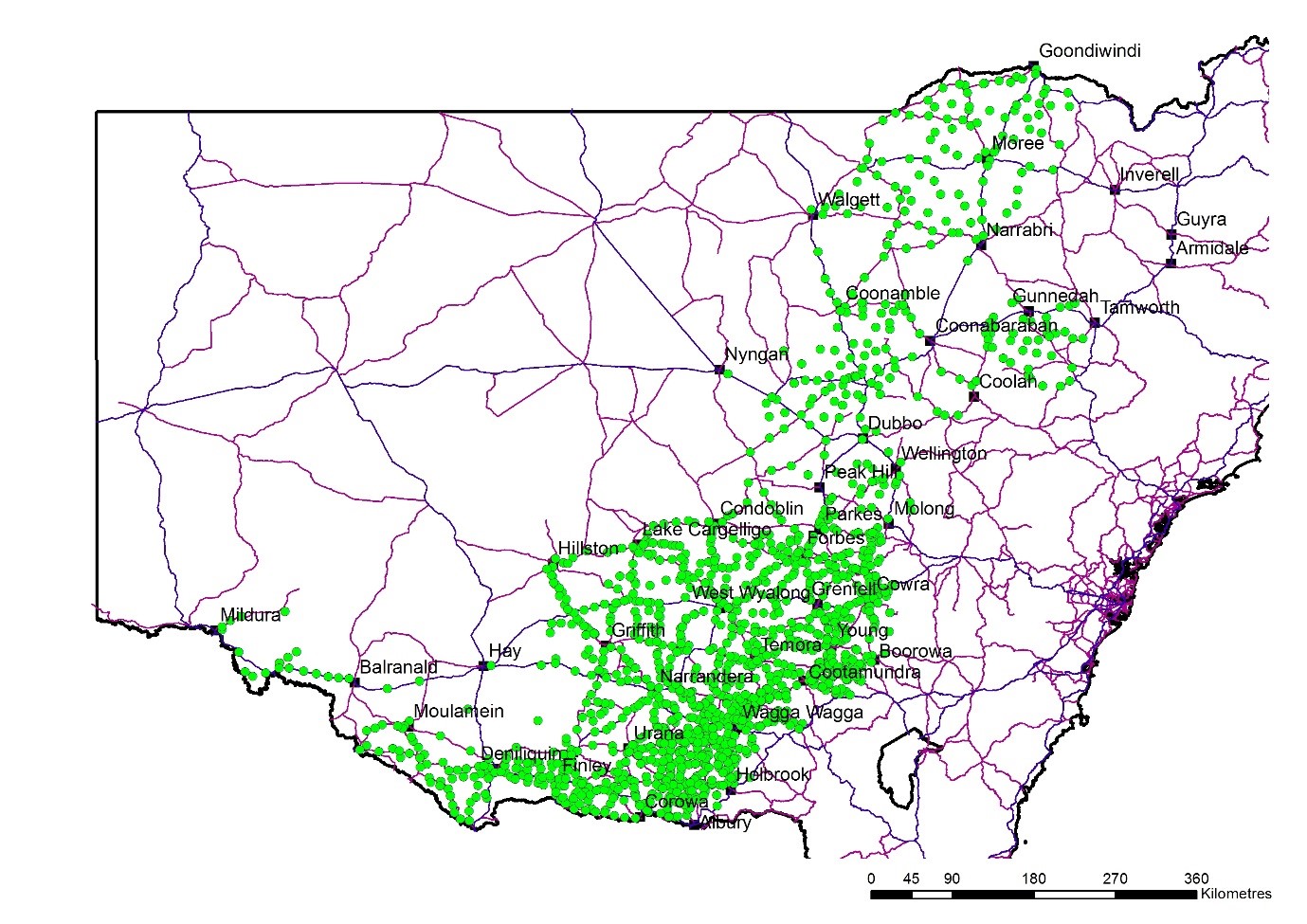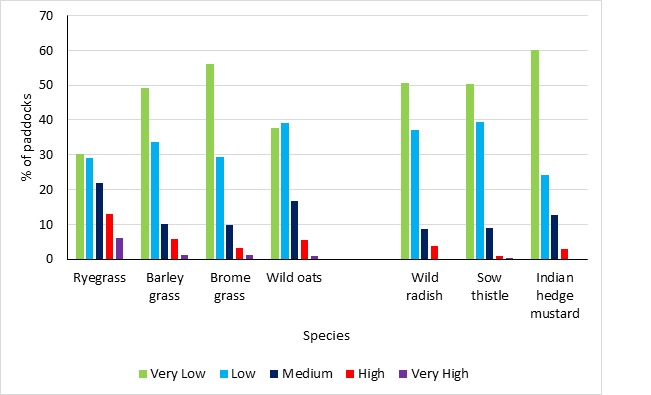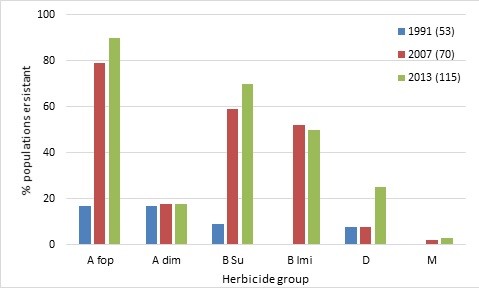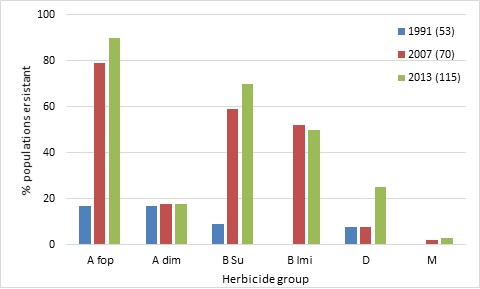Herbicide and weed management – latest research
Take home messages
- Significant levels of resistance in ryegrass to post-emergent herbicides are present across all regions of New South Wales (NSW).
- No resistance has been found to the newer ryegrass pre-emergent herbicides, Boxer® Gold and Sakura®, in the surveys carried out.
- All weed species tested have some populations with resistance.
- Despite significant levels of herbicide resistance, most weed populations are still below one plant/m2 at harvest time.
Herbicide resistance surveys
Since 2007, as part of several GRDC funded projects, Charles Sturt University (CSU) has been conducting annual surveys to determine the level of herbicide resistance across the cropping regions of NSW. Each year, a specific region of NSW is surveyed with the aim of re-surveying each region on a five year cycle. During the surveys, whenever present, samples are collected of ryegrass, wild oats, barley grass, brome grass, Indian hedge mustard and wild radish. This enables the reporting of a) differences between regions as to the extent of herbicide resistance, and b) the rate of increase between surveys.
At the same time as the sample collection, the densities of the collected species and any other species in the paddock are estimated. Densities are classified as Very Low (occasional plant), Low (<1 plant/m2), Medium (1-10 plants/m2), High (>10 plant/m2) and Very High (>10 plant/m2 and dominating crop). To allow for differences in biomass and competitiveness, species smaller than ryegrass have higher thresholds, while those larger have lower thresholds.
Results and discussion
Weed species present
Over this period, 1528 paddocks (Figure 1) have been visited across NSW resulting in 939 ryegrass, 777 wild oat, 148 barley grass, 133 brome grass, 356 sow thistle, 76 wild radish and 76 Indian hedge mustard samples being collected for herbicide resistance screening. Despite the presence of herbicide resistance in all species, and for some species in the majority of populations, many of the weeds are present only in low densities in the paddocks sampled (Figure 2).

Figure 1. Locations visited for collection of samples during surveys (2007-2017).

Figure 2. Density of different weed species across all surveys between 2010 and 2017.
Ryegrass
Results from the latest surveys across the Australian cropping region show that approximately two thirds of ryegrass populations are resistant to Group A, Aryloxyphenoxy propionate (fop) herbicides with a similar level of resistance to Group B herbicides (Table 1). The extent of resistance to both the Group A Cyclohexanediones (dim) herbicide clethodim and Group D herbicides is lower, but still at a significant level of 17% of populations. Five percent of populations across NSW, Western Australia (WA) and Tasmania (TAS) were classed as resistant to glyphosate (not tested in South Australia (SA) or Victoria (VIC)). The extent of resistance across NSW was similar to that of the overall level for the Australian cropping region with WA having the highest resistance levels for all herbicides (Table 1).
The extent of resistance varies markedly across the different survey regions in NSW. For the Group A (fop and dim) and B (sulfonylurea (SU) and imidazolinone (Imi)) herbicides, a greater percentage of populations were resistant in the Slopes (approximately between Newell and Olympic Highways, north of the Sturt Highway), higher rainfall (approximately east of the Olympic Highway) and Southern (south of Sturt Highway and east of Newell Highway) regions (Table 2). The extent of Group D resistance was highest in the Slopes and Southern regions with the other regions having few populations resistant to trifluralin.
Among the other regions, the extent of Group A fop and B resistance was only slightly lower in the Plains (approximately east of Newell Highway, and north of Irrigation Way and Kidman Way) region, but Group A dim and D resistance was markedly lower. The regions with the lowest levels of resistance to the selective herbicides, the Western (approximately west of Newell Highway, Irrigation Way and Kidman Way) and Northern (north of Peak Hill, Dubbo and Wellington) had the greatest percentage of populations resistant to glyphosate (Table 2).
Table 1. Extent of herbicide resistance in ryegrass populations from the most recent surveys across Australia and differences between States. Resistance levels are as defined by the various researchers.
Australia | NSW | WA | SA | Victoria | Tasmania | |
|---|---|---|---|---|---|---|
A fop | 64 | 64 | 96 | 48 | 50 | 46 |
A dim | 17 | 10 | 42 | 16 | 8 | 8 |
B SU | 63 | 56 | 98 | 73 | 26 | 16 |
B Imi | - | 48 | - | - | - | 20 |
D | 17 | 11 | 27 | 25 | 2 | 8 |
J/K | - | 0 | - | - | - | 0 |
K | - | 0 | - | - | - | 0 |
M | 5 | 3 | 7 | - | - | 0 |
Samples | 2039 | 597 | 466 | 606 | 318 | 52 |
Data: NSW – Broster unpublished data (Brosteret al. 2011; Brosteret al. 2013), WA - (Owenet al. 2014), SA and VIC - (Boutsaliset al. 2012), TAS - (Brosteret al. 2012)
Of the 597 ryegrass populations collected across NSW in the most recent surveys for each region, 497 of these had enough seed to be tested to five selective herbicide groups— A fop, A dim, B SU, B Imi and D. Nearly a quarter of these populations (121) were susceptible to all these herbicides, however 105 of these were, as would be expected, from the regions with the lowest resistance levels (Plains, Western and Northern) (Figure 3). Overall, nearly half of these samples were resistant to three or more herbicide groups, limiting grower options for ryegrass control with eight of the populations resistant to all five herbicides.
Table 2. Extent of herbicide resistance in ryegrass populations from the most recent surveys for various regions within NSW. Data is total of both resistant (>20% survival) and developing resistant (10-20% survival) populations.
Southern | Slopes | High Rainfall | Western | Northern | Plains | |
|---|---|---|---|---|---|---|
A fop | 79 | 90 | 84 | 23 | 44 | 71 |
A dim | 20 | 18 | 17 | 5 | 2 | 5 |
B SU | 78 | 70 | 77 | 36 | 29 | 47 |
B Imi | 56 | 50 | 87 | 30 | 33 | 44 |
D | 21 | 25 | 2 | 7 | 1 | 3 |
J/K | 0 | 0 | 0 | 0 | 0 | 0 |
K | 0 | 0 | 0 | 0 | 0 | 0 |
M | 0 | 3 | 0 | 6 | 10 | 1 |
Samples | 96 | 115 | 64 | 117 | 94 | 111 |

Figure 3. Level of cross resistance for ryegrass populations screened to five herbicide groups in NSW resistance surveys.
Previous research from the CSU herbicide resistance testing service has shown there is minimal difference between the A fop herbicides with regard to resistance development with 97% of populations tested to diclofop-methyl and haloxyfop having the same resistance status (Broster and Pratley 2006) and no difference between fops and dens (Broster and Pratley unpublished data). However, there are differences between dim herbicides with only 31% of samples screened to both tralkoxydim and clethodim having the same resistance status (Broster and Pratley unpublished data). In the surveys where samples were tested to both of these herbicides, the extent of resistance was much lower to clethodim than tralkoxydim. This was also reported in the SA and Victorian surveys (Boutsaliset al. 2012).
Of the 847 ryegrass samples that were tested to both SU and Imi herbicides, 686 (81%) had the same resistance status, slightly higher than the 70% of samples having the same resistance status when tested to both by the CSU herbicide resistance testing service. These results show that when resistance occurs to both dims and Group B herbicides, there may still be options within those groups to successfully control the weeds.
Wild oats
The extent of herbicide resistance in wild oats is much lower than ryegrass with 37% of populations resistant to Group A fops across NSW. Only two wild oat populations collected in the surveys were classed as resistant to clethodim, however in a previous survey where no samples were resistant to clethodim 14% of populations tested to tralkoxydim were resistant. The CSU herbicide resistance testing service has found 2% of wild oat populations (16/718) tested to clethodim to be resistant, compared to 40% (32/81) to tralkoxydim. This shows resistance is developing to dim herbicides and care needs to be taken to maximise the effective use of clethodim. Similar to ryegrass, there are differences regarding the extent of herbicide resistant wild oat populations for the survey regions with the higher rainfall, more intensively cropped regions having the higher resistance levels (Table 3).
Table 3. Extent of herbicide resistance in ryegrass populations from the most recent surveys for various regions within NSW. Data is total of both resistant (>20% survival) and developing resistant (10-20% survival) populations.
NSW | Southern | Slopes | High Rainfall | Western | Plains | |
|---|---|---|---|---|---|---|
A fop | 38 | 36 | 57 | 46 | 12 | 41 |
Clethodim | 1 | 0 | 0 | 0 | 0 | 2 |
B SU | 8 | 0 | 1 | 53 | 6 | 0 |
J | 0 | 0 | 0 | 0 | 0 | 0 |
Samples | 336 | 39 | 98 | 35 | 94 | 70 |
Changes over time for ryegrass and wild oats
For both ryegrass and wild oats, the Slopes and Southern regions have been surveyed three times, in 1991, 2007 and 2013. The entire Southern region was not surveyed, but the same section was surveyed every time. Over the 16 year period between the first survey in 1991 and the second in 2007, large increases in resistance were recorded for most of the herbicide groups in both the Slopes and Southern regions (Figures 4 and 5).

Figure 4. Percentage of ryegrass populations resistant in the Slopes region over three resistance surveys. Number in brackets indicates number of populations collected. In 1991, sethoxydim was used as the dim herbicide with clethodim used in 2007 and 2013.

Figure 5. Percentage of ryegrass populations resistant in the Southern region over three resistance surveys. Number in brackets indicates number of populations collected. In 1991, sethoxydim was used as the dim herbicide with clethodim used in 2007 and 2013.
Similar results were recorded in wild oats for the Group A fop herbicides with the number of populations classed as resistant increasing with each survey (Figure 6).

Figure 6. Percentage of wild oat populations resistant to Group A fop herbicide in the Slopes and Southern regions over three resistance surveys. Number indicates number of populations tested.
Barley grass and brome grass
Eight per cent of the 109 barley grass populations screened were resistant to Group B SU herbicides with populations also resistant to Group A fop and gramoxone. The majority of the resistant populations came from the western region. A total of 88 brome grass populations have been screened for resistance with all populations from the Slopes, Plains or higher rainfall regions susceptible to all tested herbicides. Of the 31 populations from the Western survey, 28% were resistant to Group B SU herbicides, 13% to Group B Imi and 11% to Group A fop herbicides.
Wild radish, sow thistle and Indian hedge mustard
Forty nine wild radish populations have been collected for resistance screening with low levels of resistance found to Group B SU (13%), Imi (5%), C (4%) and F (4%). This is significantly lower than reported in the most recent WA survey (Owenet al. 2015). This is most likely a reflection of the lower number of wild radish populations and plants treated with herbicides when compared to WA. However, these results show that resistance is developing to wild radish in NSW and growers must manage their weed control to prevent resistance reaching the extent found in WA.
Of the 212 sow thistle populations collected, 51% were resistant to Group B SU and 2% to Group I herbicides. Resistance was highest in the Plains region (69%) and lowest in the Slopes (43%) with the other regions having similar resistance levels.
Resistance has been found in 44 Indian hedge mustard populations that have been collected during the resistance surveys with 16% resistant to Groups B and 2% to Group I herbicides. No populations were resistant to Group B Imi, C, F or M.
Conclusion
More than 70% of ryegrass populations in NSW are resistant to a minimum of one selective herbicide group. Resistance is highest to the Group A fop and Group B herbicides. However, no resistance was found to the newer pre-emergent herbicides, Boxer® Gold and Sakura®. For the other species, while significant levels of resistance were found to one or two herbicide groups, the extent of resistance varied greatly between regions. The differences between the survey regions reflected differences in rainfall pattern, crop types, rotation and intensity and the prevalence and importance of the various weed species in each region.
Despite the high percentage of resistant populations across NSW, in the majority of paddocks the collected weed species were present at densities below one plant/m2. This shows that growers are using management practices to limit the impact of herbicide resistance on the seed bank.
References
Boutsalis P, Gill GS, Preston C (2012). Incidence of herbicide resistance in rigid ryegrass (Lolium rigidum) across southeastern Australia. Weed Technology 26, 391-398.
Broster JC, Koetz EA, Wu H (2011). Herbicide resistance levels in annual ryegrass (Lolium rigidum Gaud.) in southern New South Wales. Plant Protection Quarterly 26, 22-28.
Broster JC, Koetz EA, Wu H (2012). Herbicide resistance frequencies in ryegrass (Lolium spp.) and other grass species in Tasmania. Plant Protection Quarterly 27, 36-42.
Broster JC, Koetz EA, Wu H (2013). Herbicide resistance levels in annual ryegrass (Lolium rigidum Gaud.) and wild oats (Avena spp.) in south-western New South Wales. Plant Protection Quarterly 28, 126-132.
Broster JC, Pratley JE (2006). A decade of monitoring herbicide resistance in Lolium rigidum in Australia. Australian Journal of Experimental Agriculture 46, 1151-1160.
Owen MJ, Martinez NJ, Powles SB (2014). Multiple herbicide-resistant Lolium rigidum (annual ryegrass) now dominates across the Western Australian grain belt. Weed Research 54, 314-324.
Owen MJ, Martinez NJ, Powles SB (2015). Multiple herbicide-resistant wild radish (Raphanus raphanistrum) populations dominate Western Australian cropping fields. Crop and Pasture Science 66, 1079-1085.
Acknowledgements
The research undertaken as part of this project is made possible by the significant contributions of growers through both trial cooperation and the support of the GRDC. The author would like to thank them for their continued support. The work of numerous students and casual staff at CSU who have assisted in both the surveys and the resistance screening is much appreciated.
Contact details
John Broster
School of Agricultural and Wine Sciences,
Charles Sturt University,
Wagga Wagga, NSW, 2678
02 6933 4001
jbroster@csu.edu.au
Was this page helpful?
YOUR FEEDBACK
